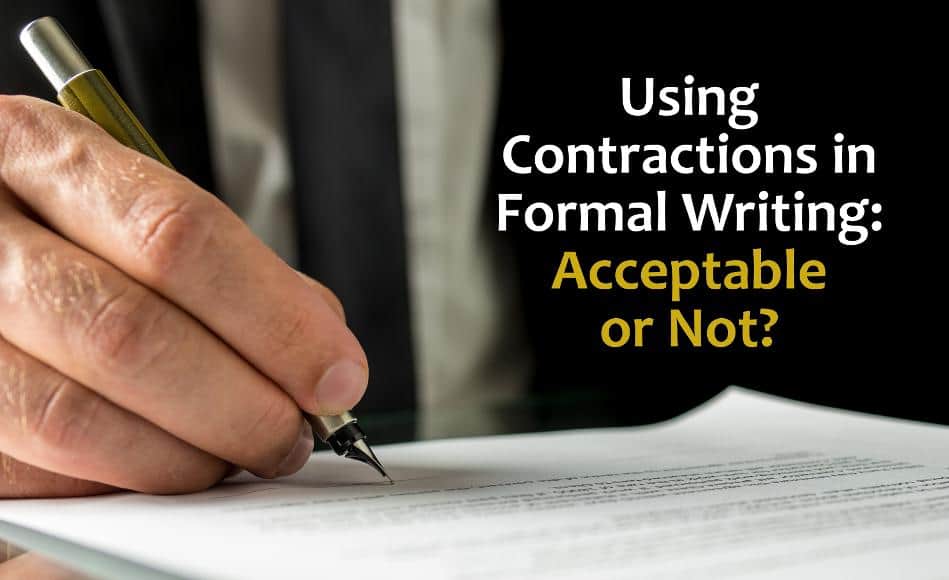What are contractions in writing? Contractions are the abbreviated forms of word combinations, such as “don’t” for “do not” or “isn’t” for “is not.” Contractions are like an appendix; they’re not that pretty, sometimes they get in the way, sometimes they can function just fine, but other times it is necessary to remove them for things to run smoothly!
Using contractions in formal writing – such as scholarly works, résumés, essays, or publications – is often frowned upon because some people believe that contractions weaken a statement or make the writing seem too casual for the situation. But is that true? It can be tricky to decipher whether or not using contractions is acceptable when writing a more formal piece. However, contractions are often quite helpful, even in professional writing, and they may even add to the overall style and format of the text.
The History of Contractions
People have been using contractions in speech for quite some time, since around the 16th century, for more or less the same reason we use them today—to save time and get ideas out faster. The use of contractions in the written word came about around the 17th century when printers had only so many vowels to use per page of text, so they began replacing vowels with apostrophes. By the late 18th century, contractions began losing favor in formal writing, although they endured in speech.

Using Contractions in Formal Writing at a Glance
Deciding whether or not to use contractions in formal writing really depends on the format and the expectations within that format. A more formal presentation and writing voice is usually required for scholarly writing, résumés or cover letters, whereas the tone of blog posts or personal essays often can be more relaxed.
When To Use Contractions
Using contractions in formal writing is permissible as it can help the writing seem more natural; however, writers are advised to use discretion. Contractions are acceptable in formal writing under these circumstances:
– When using a direct quote from an individual
– When using an idiom that already contains a contraction (removing the contraction would likely take away from the simplistic appeal of the idiom)
– When writing the footnotes of a formal piece of writing, where a break in formality is not frowned upon
– When displaying a personal voice and writing style
– When writing about contractions themselves (obviously you’ll need examples to discuss)
Examples of When To Use Contractions:
– Pollsters have been told “don’t count your chickens before they hatch,” as a sort of warning against deciding the winner of the election too soon.
– Steven Huang, a researcher studying human stem cells, reported that while his scientists had been able to refine human stem cells, “The procedure isn’t perfect, and requires a lot of eggs.”
When Not To Use Contractions
It is recommended that writers refrain from using contractions in formal essays, professional reports, and other scholarly writing; however, there is not really a hard and fast rule about when contractions are and are not allowed. Contractions can be found in pieces of writing throughout time, from classic to contemporary literature as well as in scholarly articles and professional compositions, and yet many of those pieces of writing are still considered professional and formal in tone.
Some individuals would recommend that if writers can replace the contraction with the two-word version, then they should do so to help keep the piece formal and proper in tone. However, contractions are used in real life, and not having them in a piece of writing may make the text feel inauthentic and forced. It really all depends on the voice you want to convey and the overall tone of your writing.
That being said, there are some contractions that should definitely be avoided altogether in professional writing:
Examples of When Not to Use Contractions:
– ain’t: far too informal; not considered proper grammar
– could’ve/ would’ve/ should’ve: can make the writing awkward, and writing these out sounds the same as the contraction, so use the two-word version

Final Thoughts on Contractions in Formal Writing
When writing reports, articles, or essays, if your professional writing sounds strange without any contractions, then by all means, use them. On the other hand, if your writing sounds too relaxed with all those contractions, then consider taking some out. Whatever you decide to do, do so with careful thought and attention to your tone, audience and purpose.
Are there other grammar rules that confuse you, or do you have some great tips and tricks regarding using contractions in formal writing? Do you have any other questions in regards to, “What are contractions in writing?” Well, that is what the comments are for! Please let us know below if there are other topics you’d like us to cover, or if you have more advice for us regarding contractions in formal writing. If you’re looking for help on grammar rules, check out some of our other GrammarSpot posts.


Leave a Reply